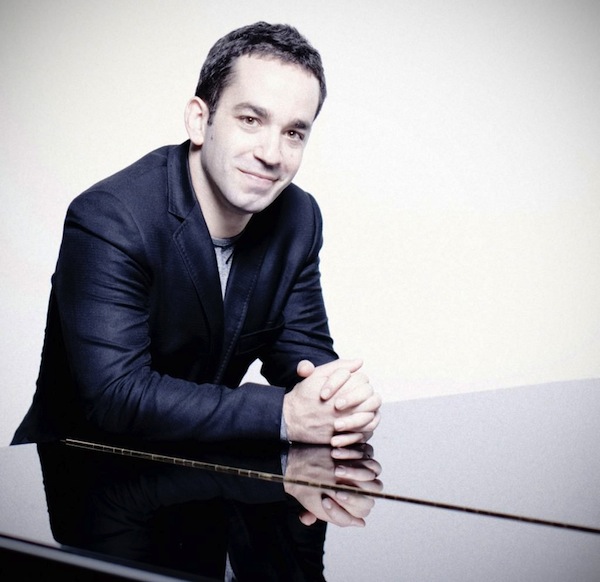Barnatan, Academy close Arsht series with stylish performances

Pianist Inon Barnatan performed with the Academy of St. Martin in the Fields Saturday night at the Arsht Center in Miami.
The Academy of St. Martin in the Fields is one of the world’s most acclaimed chamber orchestras. Long famous for its concerts and recordings under the baton of the late Sir Neville Marriner, the ensemble was led from the concertmaster’s seat by violinist Tomo Keller on Saturday night at the Arsht Center.
Yet the big news at this final season concert of the Arsht Center’s classical series was the performance of the superbly gifted Israeli pianist Inon Barnatan.
Most recently the New York Philharmonic’s artist in association, the well-traveled Barnatan is something of a young Stephen Hough. Like that British pianist, his repertoire is wide ranging and adventurous which was aptly illustrated by his playing of a Mozart concerto and a new work by Scottish composer Alasdair Nicolson. Barnatan’s technique is impeccable and it is wedded to probing musicianship. He consistently brings out the inner depth and emotion beneath a score’s surface brilliance.
Barnatan’s reading of Mozart’s Piano Concerto No. 9 in E-flat Major (“Jeunehomme”) was both nimble and patrician. He breezed through the first movement with dexterity. Trills and ornaments were assayed with spot-on accuracy. The exchanges between piano and winds came across with the subtle teamwork of chamber music players.
In the weightier Andantino, he conveyed the music’s darker undertones while maintaining a light and elegant touch. The finale is one of Mozart’s most clever and inventive rondos and Barnatan turned it into a fine display of virtuosity while the minuet-like interlude was given stylish classical grace. By any standard, Barnatan displayed exceptional Mozart playing.
Despite the chamber-size forces, the Academy’s strings produced a large sonority. Winds blended smoothly and the instrumental balances were near ideal. The players dovetailed Barnatan’s phrasing adroitly and orchestral tuttis sparkled.
In Nicolson’s Concerto No. 2 (“The Haunted Ebb”), heard in its American premiere, Nicolson attempts to evoke the folk music and pastoral aura of the Isle of Skye where he spent his youth. Unfortunately Nicolson’s comments from the stage prior to the performance were mostly unintelligible due to the Knight Concert Hall’s poor amplification system. (This has been a persistent problem when artists have attempted to address the audience. When is the management of Miami’s major concert venue going to do something about it?)
Nicolson’s four-movement work is scored for piano, strings and trumpet, the same combination as Shostakovich’s Concerto No. 1 which Barnatan and the ensemble are also playing on this tour. With the piano facing the orchestra and its lid removed, Barnatan and Keller took turns conducting and cuing the players. The work opens with slashing string chords which the piano responds to with a brief repetitive figure, leavened by a trumpet fanfare. That minimalist pattern is repeated in the second movement. For most of the concerto, the piano is utilized as more of a concertante instrument than for solo display but the third movement finally allows the keyboard to take charge with a rapid percussive motif in the manner of Bartok. The final movement–“moonlight on the sea edge”–is in the folk-like British tradition of Vaughan Williams.
Nicolson’s attempt at minimalism tended to fall flat but the final two movements were well crafted and skillfully orchestrated. From this score’s best moments, Nicolson seems to have a distinctive voice that is waiting to fully bloom. He could not have wished for more fervent advocacy than provided from Barnatan, solo trumpet Mark David and the Academy players. The composer was warmly applauded when he joined the players onstage.
David’s trumpet was even more impressive in Aaron Copland’s Quiet City, the concert’s opening work. With David and solo English horn Rachel Ingleton standing in back of the ensemble, the shadowy night sounds of Copland’s moody vignette were beautifully evoked. Ingleton’s ruminative sound and David’s clear but restrained statement of a quintessential Copland theme expertly marked the quiet but pensive mood.
The Academy is a Mozart orchestra par excellence, having played nearly all of the Salzburg wunderkind’s music over the five decades of Marriner’s tenure. Their performance of the Symphony No. 29 in A Major, arguably the first great Mozart symphony, was comparably first-rate.
The smaller forces allowed for greater transparency of individual instrumental parts. There was spring in the step of the orchestra’s crisp traversal of the Menuetto and flowing melody and forward momentum were perfectly calibrated in the Andantino. A high-speed run through the finale didn’t neglect attention to varied dynamics. The large and enthusiastic audience for this sophisticated program— one which avoided the obvious musical warhorses—is an encouraging sign of cultural progress for the Arsht Center’s classical programming.
The Academy of St. Martin in the Fields repeats the program 8 p.m. Sunday at the Kravis Center in West Palm Beach. kravis.org
Posted in Performances
Leave a Comment
Sun Mar 19, 2017
at 11:33 am
No Comments






